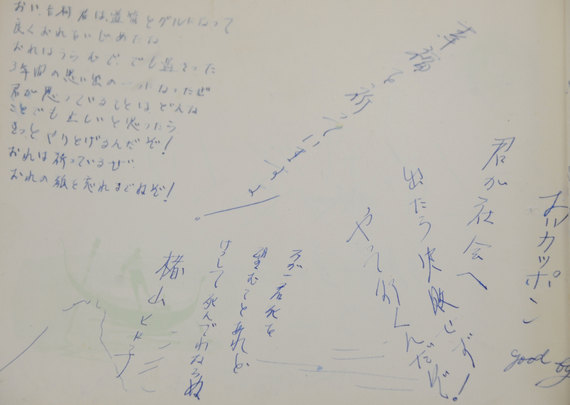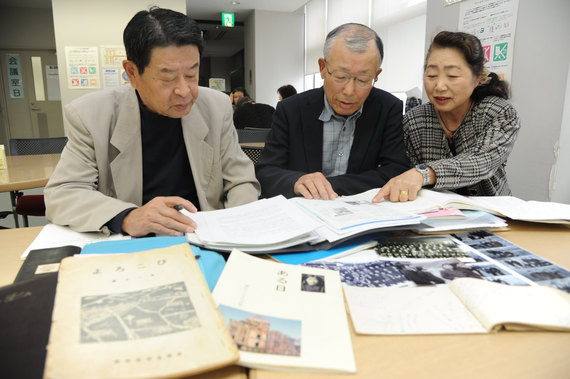It has been 70 years since the atomic bomb was dropped on Hiroshima, and 100 years since the building of what is now called the Atomic Bomb Dome. One thing that originally sparked efforts for the
was the diary of Hiroko Kajiyama, a high school student who died of leukemia as a result of radiation exposure. A former classmate who seeks to keep the memory of Hiroko alive has been collecting information in order to document her life.
A photo of Hiroko Kajiyama (second from the right) in middle school. Photo provided by classmate.
On August 6, 1945, the atomic bomb dropped by American forces exploded almost directly above the Dome. At the time, Hiroko was only a year old. She was merely 1.5 kilometers away from the blast, so she was exposed to the radiation.
The Atomic Bomb Dome was built in 1915, and named the Hiroshima Prefectural Commercial Exhibition. After the bomb flattened Hiroshima, the steel frame of the Dome's roof and parts of its walls miraculously remained intact.
After the war, some people wanted to preserve the Dome in order to display the terror of war, while others saw it as a reminder of tragedy and hatred, and wished to destroy it.
"The Hiroshima Prefectural Industrial Promotion Hall [the Atomic Bomb Dome's name after 1933] is painful to look at, and will forever call the world's attention to the horrors of the atomic bomb."
That is an excerpt from the diary that Hiroko Kajiyama kept the year before she died of leukemia at age 16. Hiroko's words greatly impacted a children's organization called the "Hiroshima Paper Crane Club." As the debate over whether to preserve or destroy the Dome continued, the children began working towards its conservation.
In 1966, the Hiroshima City Council came to the decision that the Dome would be eternally preserved. In 1996, the Dome was registered as a UNESCO World Heritage Site, and is now visited by people from around the globe.  A World Heritage Site visited by people from all over Japan and around the world. Photo provided by Hiroshima City.
A World Heritage Site visited by people from all over Japan and around the world. Photo provided by Hiroshima City.
"We want to tell people about Ms. Kajiyama."
Three years ago, Masahiro Terada and two other middle school classmates of Hiroko's started collecting information about her. Despite the major role Hiroko had played in connection with the Dome's preservation, there was hardly any data available on her life.
They interviewed about 30 of her former classmates. Some recalled that she was "small and cheerful," and that they remembered her smiling face. Others said that she had good reflexes and had always tried her best. Additionally, after looking through the writing that she left behind, they discovered her strength and her will to live.
This can also be seen in the remarks she wrote to her classmate Katsufumi Yoshimura upon graduating from middle school. She said: "In the unlikely case that you should ever wish to die, you must absolutely not die," and "I know you'll accomplish what you set your mind to. Don't forget me!" To her classmate Junko Tamura, she wrote "Stay strong!" Tamura replied: "Most people just say 'Best wishes,' or something."
 Remarks written by Hiroko to her classmate Yoshimura upon graduating from middle school. "She carried the fear of radiation sickness with her as she went about her daily life," said Tamura, who attended Hiroko's funeral. "Perhaps that was why she always worked so hard at everything."
Remarks written by Hiroko to her classmate Yoshimura upon graduating from middle school. "She carried the fear of radiation sickness with her as she went about her daily life," said Tamura, who attended Hiroko's funeral. "Perhaps that was why she always worked so hard at everything."
Terada and the others plan to complete the booklet about Hiroko's life and personal outlook this year. They are hoping that in the future, signs for the Atomic Bomb Dome and tourism pamphlets might also introduce Hiroko to the public.
They say that they want children to be learn the life philosophy that even if terrible things happen, they should do their best to overcome them and keep going.
 Masahiro Terada (center) and other former classmates collect information on Hiroko Kajiyama.
Masahiro Terada (center) and other former classmates collect information on Hiroko Kajiyama.
This article has been revised from the original article that ran in the April 27th edition of the Asahi Elementary Newspaper. You can see samples of the newspaper and read parts of articles on Junior Asahi's homepage.
This post originally appeared on HuffPost Japan and was translated into English
Support HuffPost
Our 2024 Coverage Needs You
Your Loyalty Means The World To Us
At HuffPost, we believe that everyone needs high-quality journalism, but we understand that not everyone can afford to pay for expensive news subscriptions. That is why we are committed to providing deeply reported, carefully fact-checked news that is freely accessible to everyone.
Whether you come to HuffPost for updates on the 2024 presidential race, hard-hitting investigations into critical issues facing our country today, or trending stories that make you laugh, we appreciate you. The truth is, news costs money to produce, and we are proud that we have never put our stories behind an expensive paywall.
Would you join us to help keep our stories free for all? Your contribution of as little as $2 will go a long way.
Can't afford to donate? Support HuffPost by creating a free account and log in while you read.
As Americans head to the polls in 2024, the very future of our country is at stake. At HuffPost, we believe that a free press is critical to creating well-informed voters. That's why our journalism is free for everyone, even though other newsrooms retreat behind expensive paywalls.
Our journalists will continue to cover the twists and turns during this historic presidential election. With your help, we'll bring you hard-hitting investigations, well-researched analysis and timely takes you can't find elsewhere. Reporting in this current political climate is a responsibility we do not take lightly, and we thank you for your support.
Contribute as little as $2 to keep our news free for all.
Can't afford to donate? Support HuffPost by creating a free account and log in while you read.
Dear HuffPost Reader
Thank you for your past contribution to HuffPost. We are sincerely grateful for readers like you who help us ensure that we can keep our journalism free for everyone.
The stakes are high this year, and our 2024 coverage could use continued support. Would you consider becoming a regular HuffPost contributor?
Dear HuffPost Reader
Thank you for your past contribution to HuffPost. We are sincerely grateful for readers like you who help us ensure that we can keep our journalism free for everyone.
The stakes are high this year, and our 2024 coverage could use continued support. If circumstances have changed since you last contributed, we hope you’ll consider contributing to HuffPost once more.
Already contributed? Log in to hide these messages.
 A World Heritage Site visited by people from all over Japan and around the world. Photo provided by Hiroshima City.
A World Heritage Site visited by people from all over Japan and around the world. Photo provided by Hiroshima City. Remarks written by Hiroko to her classmate Yoshimura upon graduating from middle school. "She carried the fear of radiation sickness with her as she went about her daily life," said Tamura, who attended Hiroko's funeral. "Perhaps that was why she always worked so hard at everything."
Remarks written by Hiroko to her classmate Yoshimura upon graduating from middle school. "She carried the fear of radiation sickness with her as she went about her daily life," said Tamura, who attended Hiroko's funeral. "Perhaps that was why she always worked so hard at everything."